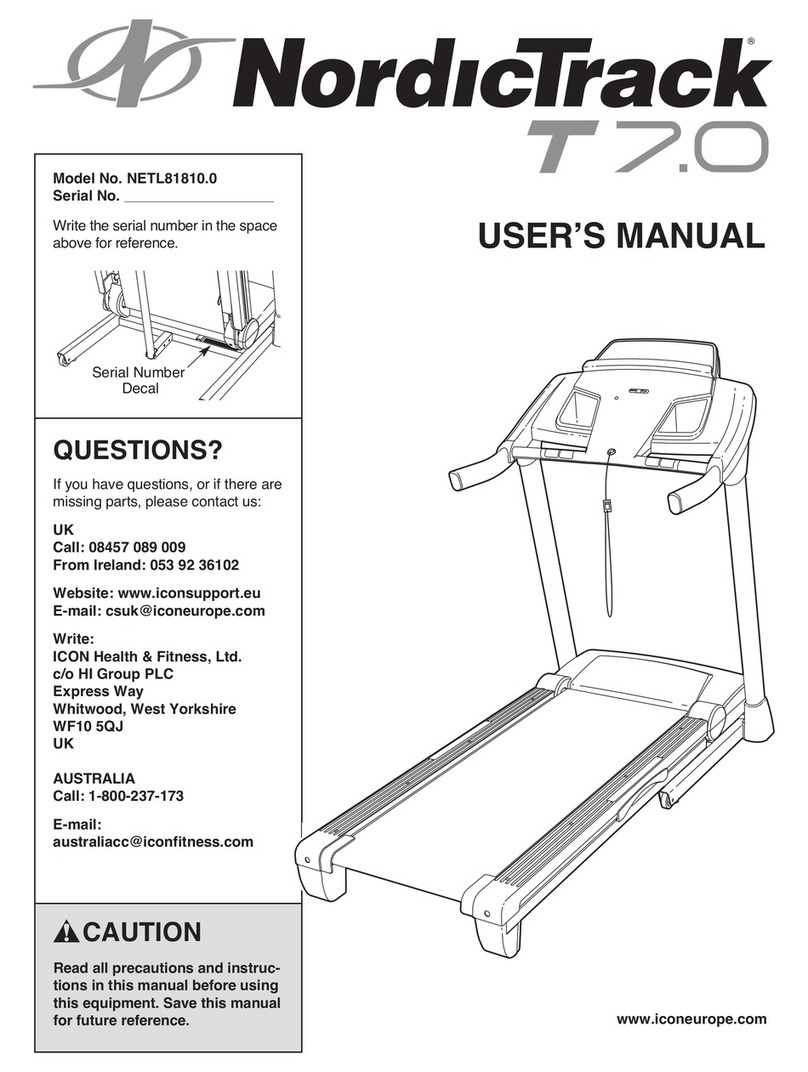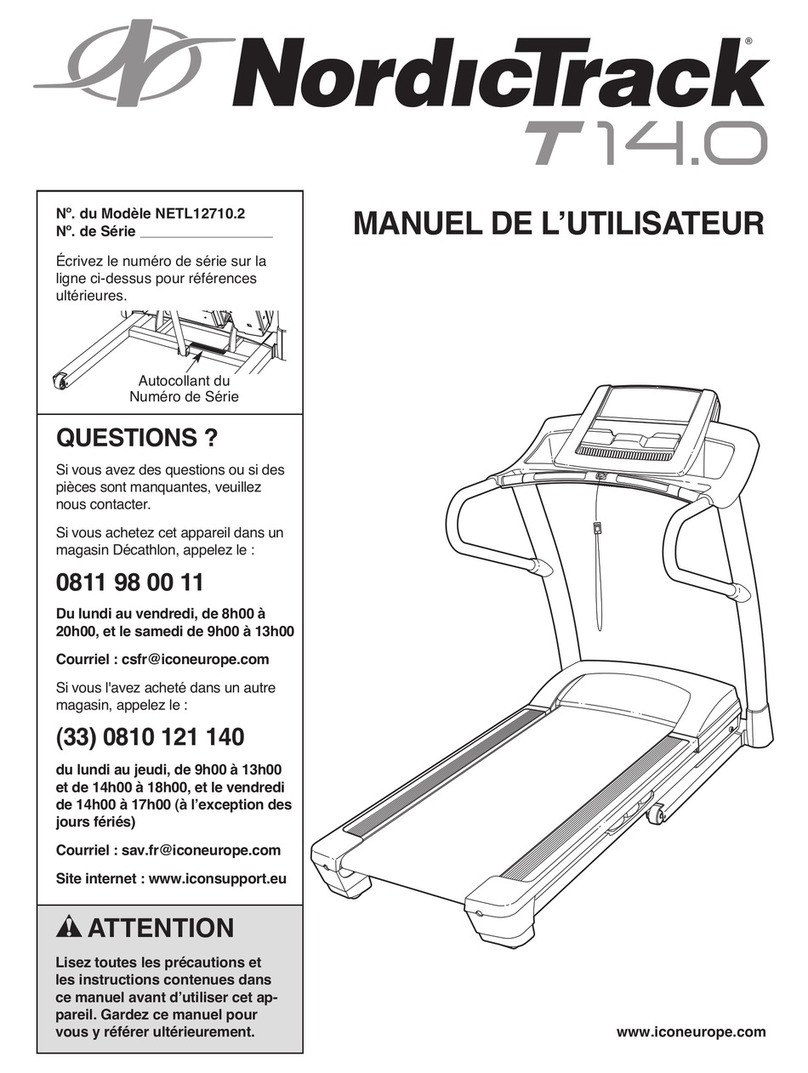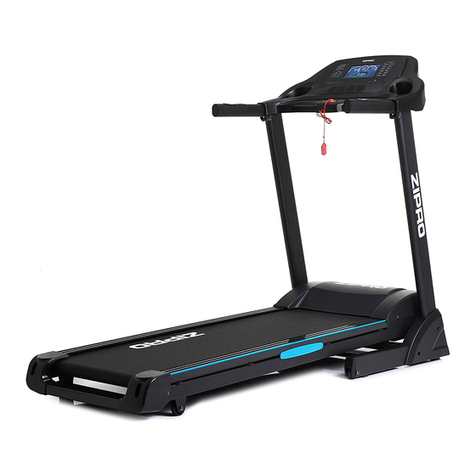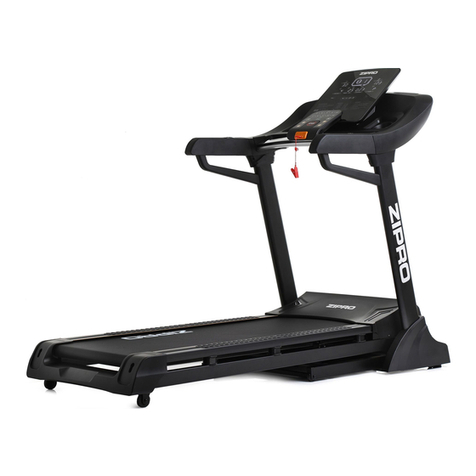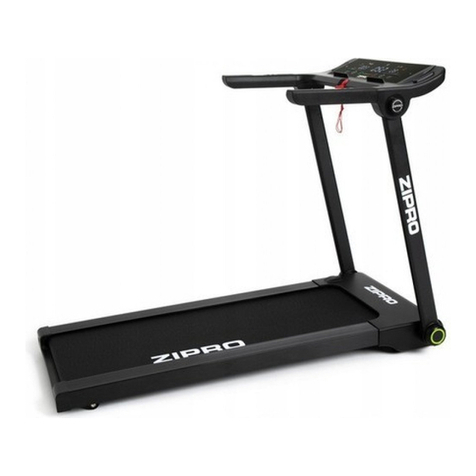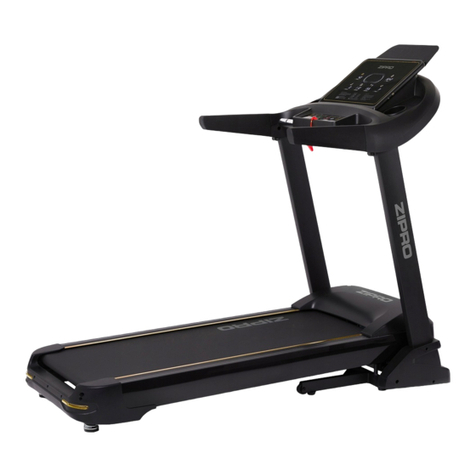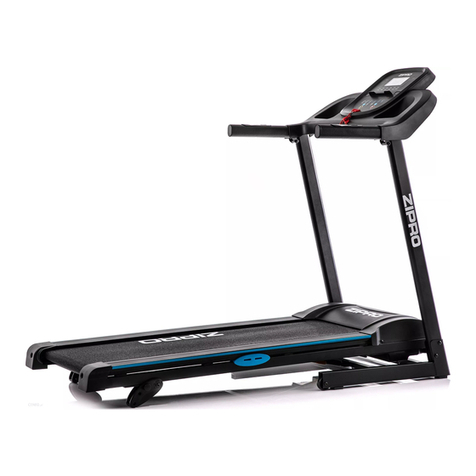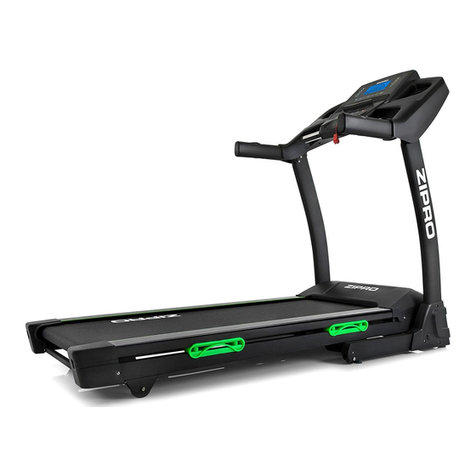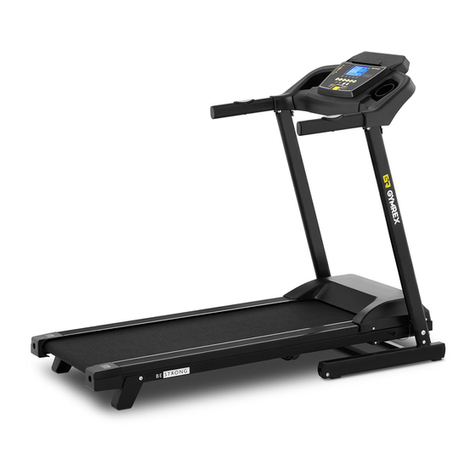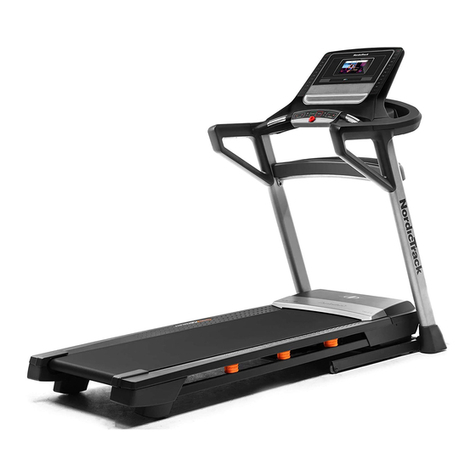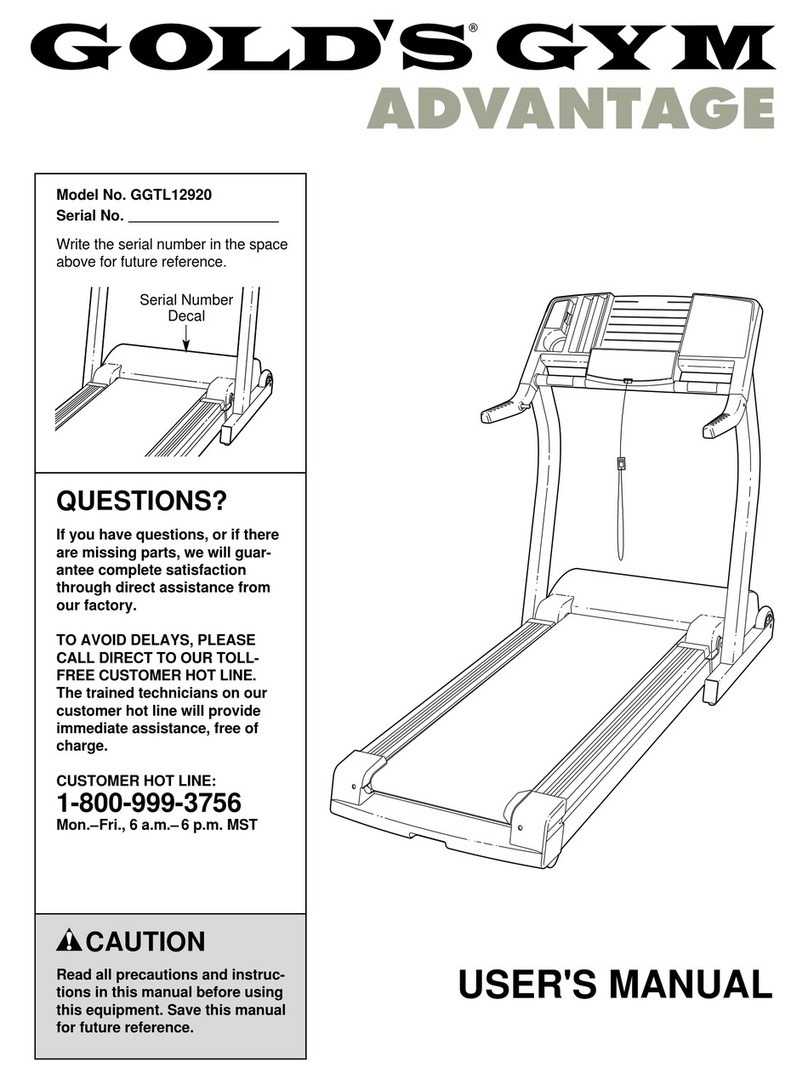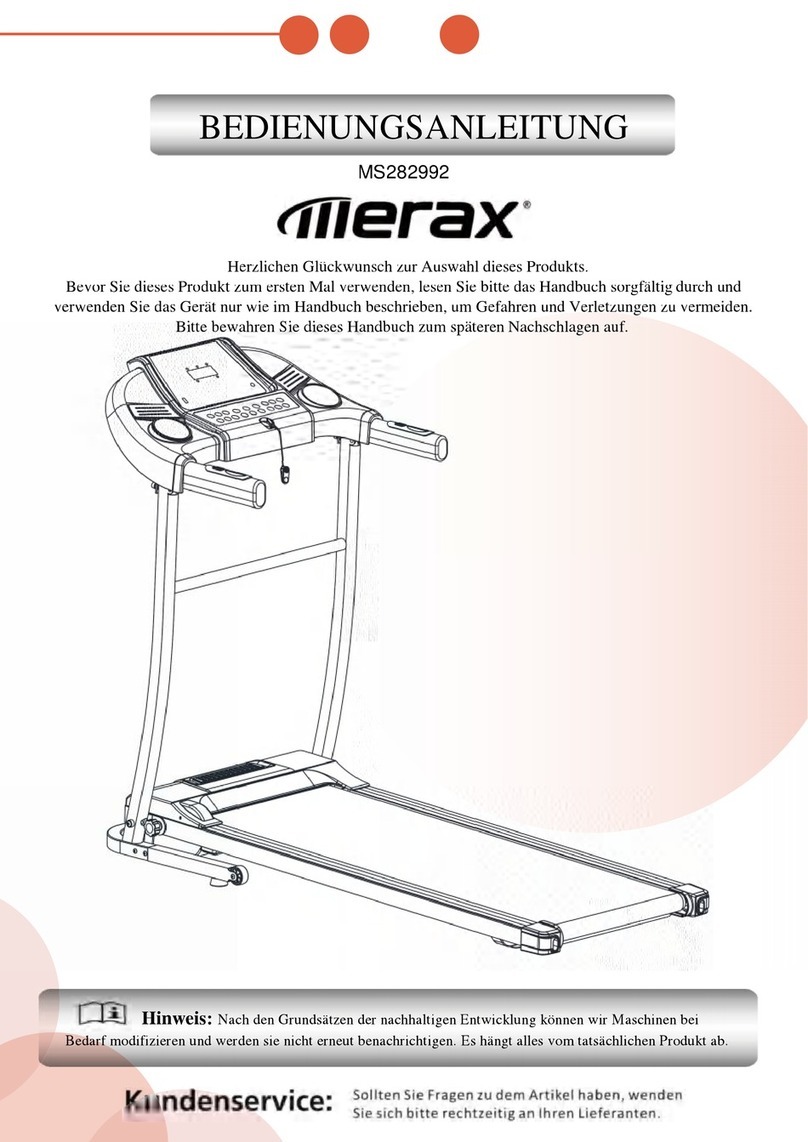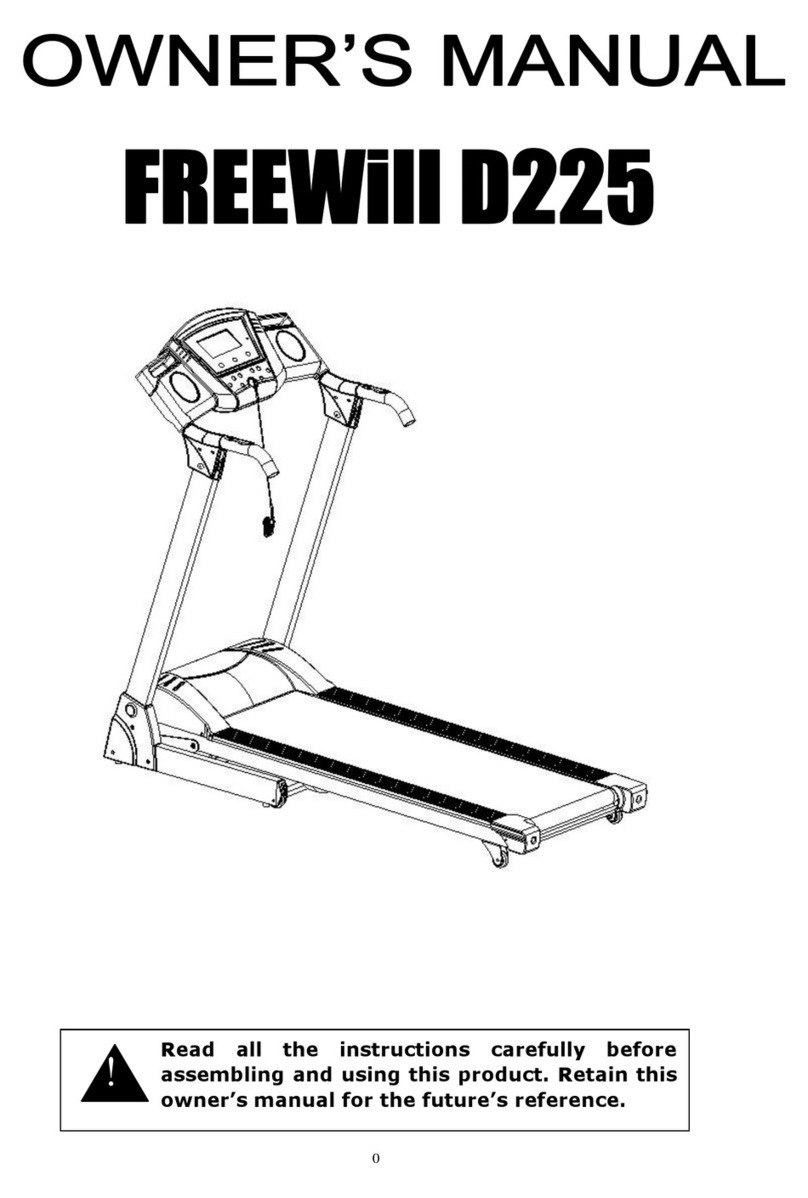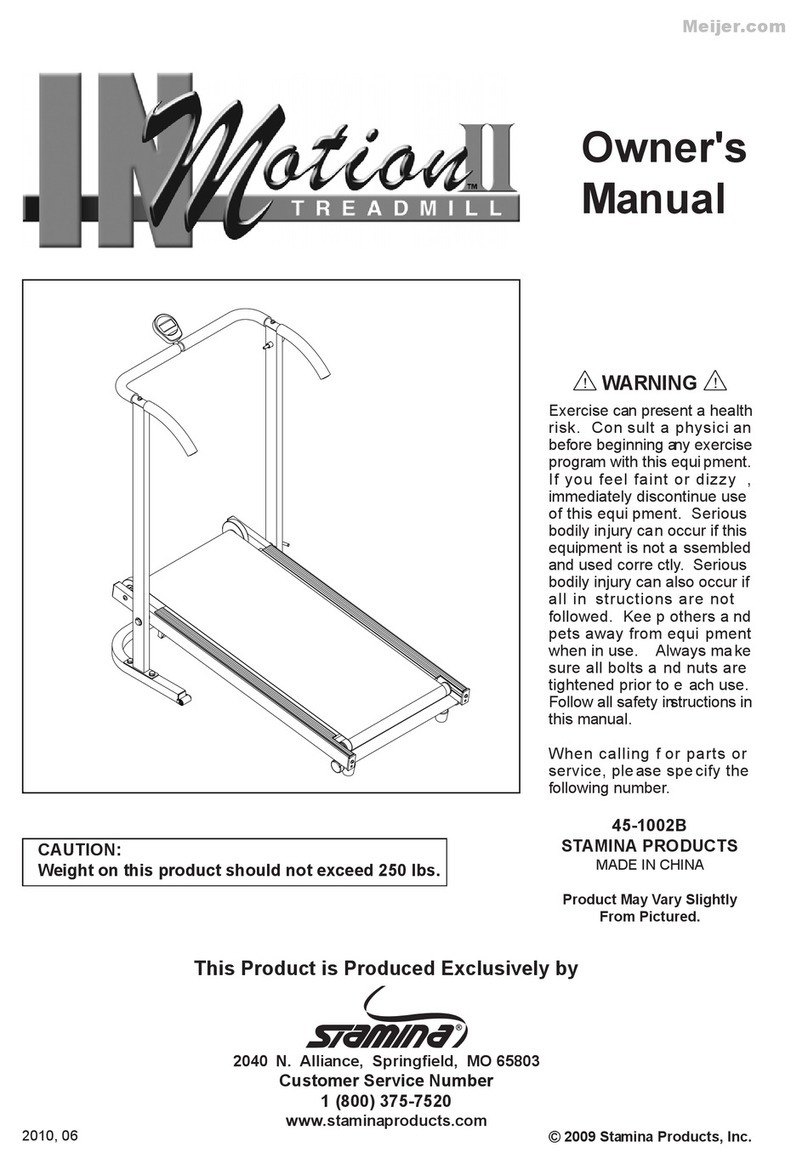
3
PL Podręcznik użytkowania
Użytkowniku,
Zapoznaj się z poniższą instrukcją przed rozpoczęciem montażu
i pierwszym użyciem urządzenia. Instrukcja ta zawiera ważne
informacje dotyczące bezpieczeństwa użytkowania i konserwacji
sprzętu. Zachowaj ją w celu możliwości skorzystania z informacji
dotyczących konserwacji lub zamawiania części zamiennych.
DANE TECHNICZNE
Temperatura przechowywania
o
o
Maksymalna waga użytkownika
3 poziomy ustawiane
manualnie
Norma wyrobu (główna) EN 957-6
Bieżnia elektryczna do
użytku domowego
BEZPIECZEŃSTWO
UWAGA! Z urządzenia można korzystać wyłącznie zgodnie z jego
przeznaczeniem, czyli do treningu przez osoby dorosłe. Każde inne
zastosowanie urządzenie może być niebezpieczne. Producent nie może
być pociągany do odpowiedzialności za szkody, które zostały
spowodowane nieprawidłowym użytkowaniem urządzenia.
•Urządzenie zostało zaprojektowane i skonstruowane
w oparciu o najnowszą wiedzę z zakresu bezpieczeństwa.
Elementy niebezpieczne, które potencjalnie mogą być stanowić
zagrożenie odniesienia obrażeń zostały wyeliminowane lub
względnie zabezpieczone.
•Nie dopuszcza się napraw i zmian na własną rękę.
•Raz na jeden lub dwa miesiące sprawdź poprawność dokręcenia
śrub, wkrętów i nakrętek.
•W celu trwałego zapewnienia bezpieczeństwa regularnie (czyli
jeden raz w roku) sprawdzaj i konserwuj sprzęt
w specjalistycznej placówce handlowej.
•Wszystkie zmiany na urządzeniu, które nie zostały opisane
w niniejszej instrukcji mogą stanowić przyczynę uszkodzeń lub
bezpośrednio zagrażać zdrowiu i życiu osoby ćwiczącej. Zmian
na urządzeniu mogą dokonywać wyłącznie pracownicy serwisu
producenta lub osoby przeszkolone przez nie w tym zakresie.
•Wszystkie urządzenia podlegają stałym działaniom
innowacyjnym w celu zapewnienia wysokiej jakości.
Z tego powodu producent zastrzega sobie prawo
do wprowadzania zmian technicznych.
•Wszelkie pytania lub wątpliwości związane ze sprzętem kieruj
do specjalistycznej placówki handlowej.
UWAGA! Przestrzegaj zasad ogólnych przepisów
i środków bezpieczeństwa obowiązujących dla
obchodzenia się z urządzeniami elektrycznymi.
•Urządzenie jest zasilane napięciem sieciowym 230V.
•Wszystkie urządzenia elektryczne w trakcie pracy emitują
promieniowanie elektromagnetyczne. Jeśli w pobliżu
elektronicznego układu sterowniczego lub kokpitu umieszczone
są inne urządzenia emitujące takie promieniowanie (np.
telefony komórkowe), to niektóre wartości (takie jak np. tętno)
mogą zostać zniekształcone.
•UWAGA! Nigdy nie dokonuj na własną rękę żadnych modyfikacji
w sieci elektrycznej. Zmiany takie zlecaj specjalistom.
•UWAGA! Pamiętaj, aby przed rozpoczęciem wykonywania
wszelkich napraw, konserwacji lub czyszczenia sprzętu wyjąć
wtyczkę zasilania z gniazdka.
•Do podłączania urządzenia nie stosuj przedłużaczy.
•Jeśli przez dłuższy nie będziesz korzystać ze sprzętu, wyjmij
jego wtyczkę zasilania z gniazdka.
•Zwróć uwagę na to, aby przewód elektryczny nie był
przygnieciony i jego ułożenie nie powodowało ryzyka
potknięcia się o niego.
UZIEMIENIE
Uziemienie zabezpiecza przed ryzykiem porażenia prądem. Urządzenie
posiada przewód i wtyczkę z uziemieniem. Wtyczka musi być
podłączona do poprawnie zainstalowanego i właściwie uziemionego
gniazdka sieciowego.
NIEBEZPIECZEŃSTWO! Niewłaściwe podłączenie przewodu może
powodować ryzyko porażenia prądem elektrycznym.
•Przed podłączeniem urządzenia do zasilania upewnij się,
że lokalne napięcie odpowiada rodzajowi wtyczki.
•Nie modyfikuj wtyczki, jeśli nie pasuje ona do gniazdka.
W takim przypadku zleć zainstalowanie innego gniazdka
wykwalifikowanemu elektrykowi.
UWAGA! Osoby przebywające w pobliżu w trakcie użytkowania sprzętu
należy uprzedzić o ewentualnych zagrożeniach. Zachowaj szczególną
ostrożność w obecności dzieci.
UWAGA! Przed przystąpieniem do ćwiczeń skonsultuj się z lekarzem
w celu upewnienia się, czy nie masz żadnych przeciwwskazań
zdrowotnych do prowadzenia treningów na urządzeniu. W oparciu
o opinię specjalisty możesz opracować swój plan treningowy.
Nieprawidłowo dobrany program lub nadmierne ćwiczenia mogą być
niebezpieczne dla Twojego zdrowia i życia.
OSTRZEŻENIE! Systemy monitorowania tętna mogą być
niedokładne. Przemęczenie podczas ćwiczeń może skutkować
poważnymi obrażeniami lub śmiercią. Jeśli czujesz się słabo,
natychmiast przestań ćwiczyć.
UWAGA! Bezwzględnie przestrzegaj uwag dotyczących prowadzenia
treningu zawartych w niniejszej instrukcji.
•Wybierając miejsce do prowadzenia treningu uwzględnij
zapewnienie sobie bezpiecznych odległości od możliwych
przeszkód. Nie ustawiaj sprzętu w pobliżu ciągów
komunikacyjnych (dróg, bram, przejść itp.).
•Zabrania się użytkowania sprzętu w bliskiej odległości
od ściany. Strefa bezpieczeństwa wynosi 2000 mm i co najmniej
takiej szerokości jak urządzenie.
UWAGA! W trakcie montażu urządzenia zachowaj ostrożność i nie
pozwalaj przebywać w pobliżu dzieciom. Podczas montażu używane są
drobne części (nakrętki, śruby itp.), które mogą zostać przez nie
połknięte.
RYZYKO RESZTKOWE
•W sytuacji, gdy zabezpieczenie przed upadkiem nie zostanie
zastosowane lub zostanie, ale nieprawidłowo, istnieje ryzyko
resztkowe, czyli upadek osoby powodujący otarcia skóry,
siniaki, złamania lub, w najgorszym przypadku, śmierć.
•Istnieje ryzyko resztkowe niezamierzonego przeciążenia osoby
ćwiczącej spowodowanego nieprawidłową obsługą lub
niewłaściwą oceną, a także nieprawidłowym przesłaniem
danych (z powodu zakłóceń elektromagnetycznych, błędu
oprogramowania itp.).
Nawet najlepsze zabezpieczenie oprogramowania i sprzętu nie
wyklucza błędu oprogramowania czy sprzętu i może
teoretycznie spowodować przeciążenie osoby ćwiczącej.
•Produkt jest urządzeniem elektrycznym, dlatego nie można
wykluczyć porażenia prądem, które może doprowadzić do
śmierci.
•Nie można wykluczyć ryzyka resztkowego uduszenia.

